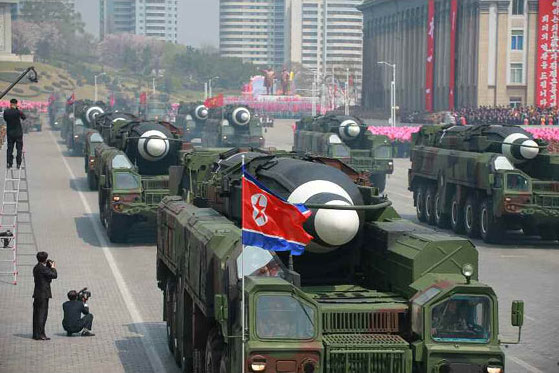North Korea’s Latest Missile Test: Advancing towards an Intercontinental Ballistic Missile (ICBM) While Avoiding US Military Action
North Korea’s latest successful missile test represents a level of performance never before seen from a North Korean missile. The missile would have flown a distance of some 4,5oo kilometers if launched on a maximum trajectory. It appears to have not only demonstrated an intermediate-range ballistic missile (IRBM) that might enable them to reliably strike the US base at Guam, but more importantly, may represent a substantial advance to developing an intercontinental ballistic missile (ICBM). Given speculation over the past months about the possibility of military action by the Trump administration to prevent Pyongyang from acquiring such a weapons, the possible testing of ICBM subsystems in this low-key manner may be a North Korean hedge against the possibility of such action.
We are still awaiting more details on this test, and if the North Koreans follow their usual practice we can expect photographs soon. But unless Pyongyang is hiding something completely new, there’s only one real candidate for this missile. During last month’s parade, one genuinely new missile was revealed—one that looks very much like a small, two-stage version of their three-stage KN-08 ICBM prototype, displayed on a mobile launcher previously used for the “Musudan” intermediate-range ballistic missile. We don’t have a name for this missile yet; the “KN-17” designation has been used for both this system and for a Scud-derived short-range ballistic missile with a maneuvering reentry vehicle (RV) displayed in the same parade. But whatever the name, it would be expected to have about the same performance as the missile just launched.

While the April 15 parade may be the first time this missile was seen, and yesterday’s test may be its first successful flight, there have been earlier indications that such a missile was under development. In January this year, intelligence sources reported that North Korea had deployed two prototype ICBMs at a test site, just under 15 meters long. All of North Korea’s ICBM prototypes and mock-ups are well over that size, which left us puzzled. But this new missile comes in at just under 15 meters, and while its performance doesn’t quite reach ICBM standards, it clearly shares a common heritage with the KN-08 ICBM. Quite likely this was the missile that was reported in January.
This missile may have been tested on other occasions. Two failed missile tests from Kusong in October were presumed to be Musudans, but there was no solid evidence to confirm that—and the Musudan had recently been tested successfully, so it would be somewhat surprising for it to fail twice in a row. It wouldn’t be at all surprising for a new missile to fail twice, and if the missile was launched from a Musudan TEL, it might well be mistaken for a Musudan. Another failed test, on April 16, was initially ascribed to a new maneuvering reentry vehicle system, but may have been this missile instead—both were initially displayed in the parade the previous day, and a successful test of either one would neatly highlight the propaganda event.
While this missile appears to share a common heritage with the KN-08 ICBM, it isn’t simply a KN-08 with the third stage removed. The first two stages also appear to be reduced in scale. Unfortunately, we have little detail about the missile’s design. We do not, for example, know if it uses the same twin-engine propulsion system as the first stage of the KN-08. But the more important question is, what is the new missile for?
One possibility is that it is meant to replace the Musudan IRBM which represents an attempt to stretch a Cold War vintage Russian missile to reach the US base at Guam, some 3,500 km from North Korean launch sites. But the Musudan has proven unreliable in testing, with only one success in at least six attempts, and its performance is marginal for reaching Guam. The Musudan may have been the best North Korea could manage ten years ago, but that level of performance really calls for a two-stage missile. Now, it appears that they have one. But existing North Korean missiles are already capable of reaching targets anywhere in South Korea or Japan, and extending that reach to perhaps 4,500 kilometers won’t greatly change the strategic balance—aside from Guam, there aren’t really any interesting targets in that range.
What would change the strategic balance is an ICBM capable of reaching the US mainland. This is not that missile but it might be a testbed, demonstrating technologies and systems to be used in future ICBMs like the KN-08 and KN-14. A full three-stage KN-08 would be very unlikely to work the first time it was tested, and the failure would be both expensive and very provocative. This missile would allow North Korea to conduct at least some of the testing necessary to develop an operational ICBM without actually launching ICBMs, particularly if it includes the same rocket engines.
If North Korea has already conducted a successful test using the engines and other components of the first two stages of the KN-08, it may be closer to an operational ICBM than had been previously estimated. US cities will not be at risk tomorrow, or any time this year, since some tests have to be done with the full-scale system. With only one test of this reduced-scale system thus far, Pyongyang is probably some time away from even beginning that process. But given this test and the possible North Korean path forward, a closer look is necessary to see how much progress has been made and what technologies the North may have demonstrated, as well as a reassessment of their ICBM program in that new light.
